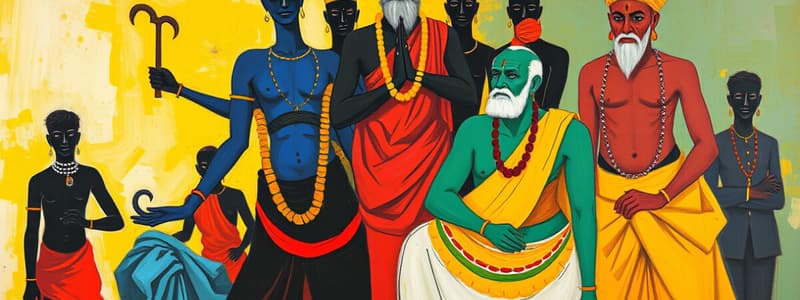Podcast
Questions and Answers
What is the Hindu caste system properly known as?
What is the Hindu caste system properly known as?
- Caste Hierarchy
- Laws of the Manu (correct)
- Manusmriti
- Varna System (correct)
Which major groups were divided under the Laws of Manu?
Which major groups were divided under the Laws of Manu?
Brahmin, Kshatriyas, Vaishyas, Sudras
The Brahmins were considered the ______ in the original caste system.
The Brahmins were considered the ______ in the original caste system.
head
Gandhi referred to untouchables as Harijan, meaning children of god.
Gandhi referred to untouchables as Harijan, meaning children of god.
What action did Prime Minister Jawaharlal Nehru take regarding untouchability?
What action did Prime Minister Jawaharlal Nehru take regarding untouchability?
What was the common problem related to marriage in the caste system?
What was the common problem related to marriage in the caste system?
In the caste system, it was forbidden to kill cows.
In the caste system, it was forbidden to kill cows.
What was the role of untouchables in society?
What was the role of untouchables in society?
Over many years, major castes divided into hundreds of sub castes called ______.
Over many years, major castes divided into hundreds of sub castes called ______.
Education in the caste system was available to all children.
Education in the caste system was available to all children.
What does the term 'varna' refer to?
What does the term 'varna' refer to?
What was the societal belief about the origins of the caste system according to one theory?
What was the societal belief about the origins of the caste system according to one theory?
Flashcards are hidden until you start studying
Study Notes
Caste System Overview
- The Caste or Varna system, known formally as the Laws of Manu, originated approximately two thousand years ago and aimed to protect people. Over time, it transformed into a rigid social structure that inhibited progress.
Major Caste Groups
- The Laws of Manu classified Hindus into four main groups: Brahmins (priests and scholars), Kshatriyas (rulers and warriors), Vaishyas (traders and businessmen), and Shudras (workers).
Symbolic Representation
- The original caste system symbolically represented parts of the human body: Brahmins as the head, Vaishyas as the hands, Shudras as the feet. This complex structure evolved into numerous sub-castes under each category.
Untouchables
- Untouchables, later renamed Harijan by Gandhi meaning "children of God," were marginalized by the caste system and given labels such as Scheduled by the British.
Legal Changes
- Prime Minister Jawaharlal Nehru abolished untouchability in independent India in 1947, but societal adherence to this law remained weak due to the vast population and insufficient enforcement.
Housing Disparities
- Higher castes resided in better living conditions, while lower castes were relegated to poorer areas. Inappropriate for lower castes to own houses higher than those of higher castes.
Social Restrictions
- Marrying outside one's caste was prohibitive, and social interactions, such as sharing gifts or smoking hookah, were strictly avoided across caste lines.
Cow Protection
- Killing cows was forbidden, and touching dead animals was taboo, despite leather being essential for village products like shoes and harnesses.
Untouchables’ Status
- Untouchables were ostracized and deemed polluting through contact, performing jobs viewed as unclean, like skinning animals or cleaning latrines, and were barred from temples and public wells.
Emergence of Sub-Castes
- Major castes have diversified into numerous sub-castes (jatis), which consist of families adhering to specific customs, especially in terms of dietary practices and marriage.
Job Restrictions
- Individuals were born into their caste, with strict limits on acceptable occupations. Breaking caste rules resulted in communal punishment and anticipated repercussions in future lives.
Educational Focus
- The caste system promoted education predominantly for job-specific training, with Brahmins playing a critical role in the preservation and transmission of knowledge.
Misconceptions of Racial Nature
- Varnas (caste groups) are not racial categories but social classes with distinct, hereditary occupational roles, debunking assumptions of a racially-based culture.
Theories of Origin
- One theory posits that the caste system's roots lie in the Aryan invasion from Central Asia, which contributed to the establishment of these social structures in South Asia.
Studying That Suits You
Use AI to generate personalized quizzes and flashcards to suit your learning preferences.




